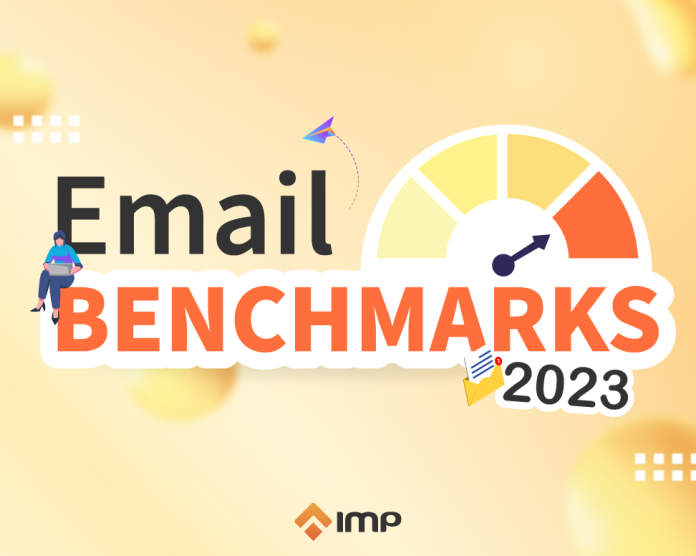As technology and customer behavior evolve, staying up-to-date with the latest email marketing trends is essential so businesses can ensure their strategies are effective. In this article, we’ll help you understand how different metrics will change over the years and provide insights on key performance indicators to watch for that reflect whether your campaigns have succeeded.
Read on to learn more about modern email marketing benchmarks and how they will affect your business come 2023!
Email marketing benchmarks by industry
Here is an expanded overview of email marketing benchmarks by the industry for 2023. These benchmarks provide valuable insights into the performance of email marketing campaigns across various sectors, helping businesses assess their email marketing strategies’ effectiveness and identify areas for improvement.
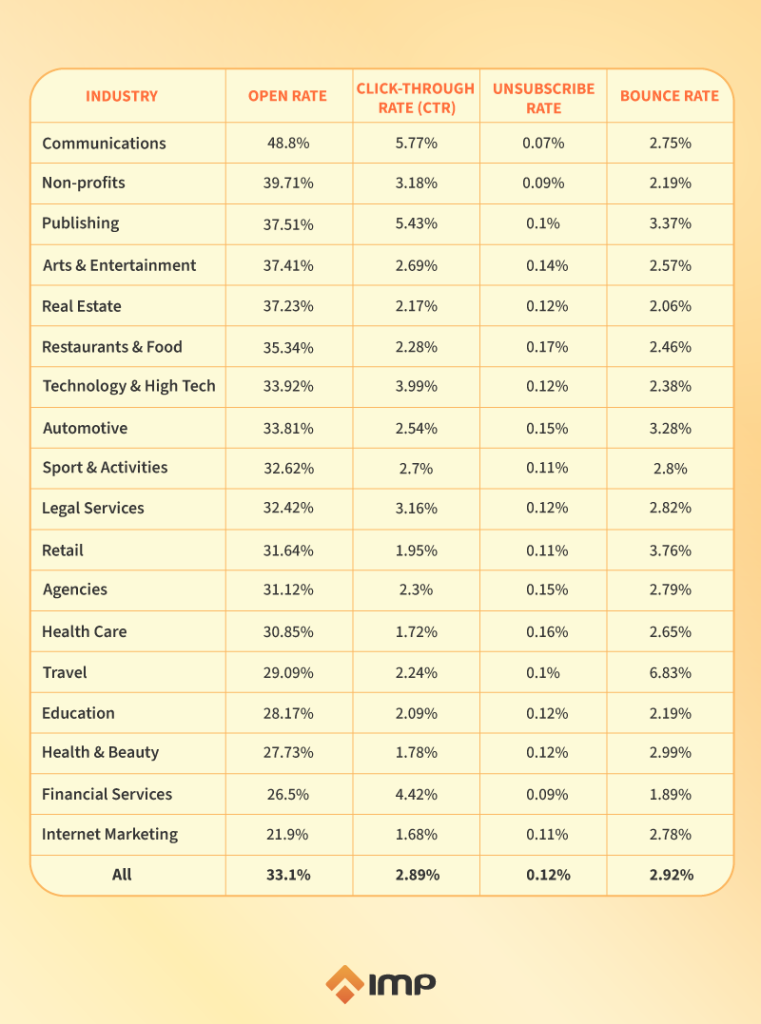
The top industries are Communications, Publishing, and Financial Services. These industries have higher-than-average click-through rates (4.42%-5.77% vs. 2.89%).
At the bottom are Health and beauty, Healthcare, and Internet Marketing, with average CTRs of 1.68% to 1.78%, below the overall average of 2.89%. Most industries showed improvement, with no significant shifts in rankings.
Travel had higher-than-average bounce rates (6.83% vs. 2.92%). This discrepancy suggests that while Travel industry emails capture attention initially, there may be room for improvement in retaining engaged subscribers.
Email marketing benchmarks by country
If you understand how email marketing performs in different countries, tailoring campaigns to specific audiences would be easier. Here’s an overview of email marketing benchmarks across various countries:
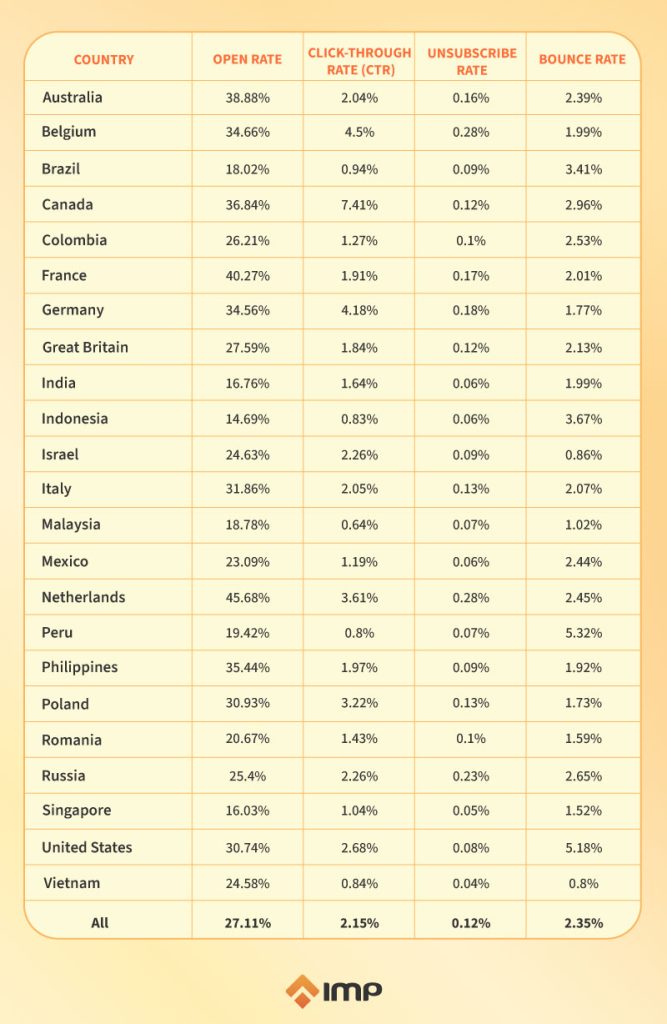
The three countries with the best open rates – The Netherlands, France, and Australia – stand out for providing more robust safeguards and personal data control.
Meanwhile, regarding click-through rates, the top performers are Canada, Germany, and Belgium. These countries operate under GDPR (The General Data Protection Regulation is the world’s strictest privacy and security law) and PIPEDA (The Personal Information Protection and Electronic Documents Act is a Canadian law relating to data privacy) regulations.
What’s the best time to send emails?

Two ideal time slots: early morning (4-6 AM) or late afternoon (5-7 PM). At these moments, inboxes are less crowded, increasing the chances of capturing your audience’s attention.
Early Morning (4-6 AM):
- This time slot offers a fresh start to the day for many recipients. When they check their emails upon waking up, your message may stand out more prominently in their less-cluttered inbox.
- Consider targeting professionals who like to get an early jump on their day or individuals in different time zones who may already be active during these hours.
Late Afternoon (5-7 PM):
- Towards the end of the workday, people are often wrapping up their tasks and may take a moment to catch up on emails.
- This time can be particularly effective for B2B emails, as professionals may be winding down and more receptive to exploring new opportunities or solutions.
- For B2C emails, targeting individuals who have finished their workday or are commuting home can also yield positive results.
What’s the best day to send emails?

While Mondays and Fridays used to be the top performers, Tuesdays now come out on top with slightly higher open and click-through rates. However, the differences between these weekdays are still relatively small compared to other days.
On the other hand, the weekends show lower average metrics. Therefore, it’s recommended to focus your email campaigns on weekdays.
Don’t be afraid to experiment with different weekdays to find the perfect fit for your audience. Remember, the key to higher engagement lies in delivering valuable content that connects with your recipients.
Number of newsletters per week
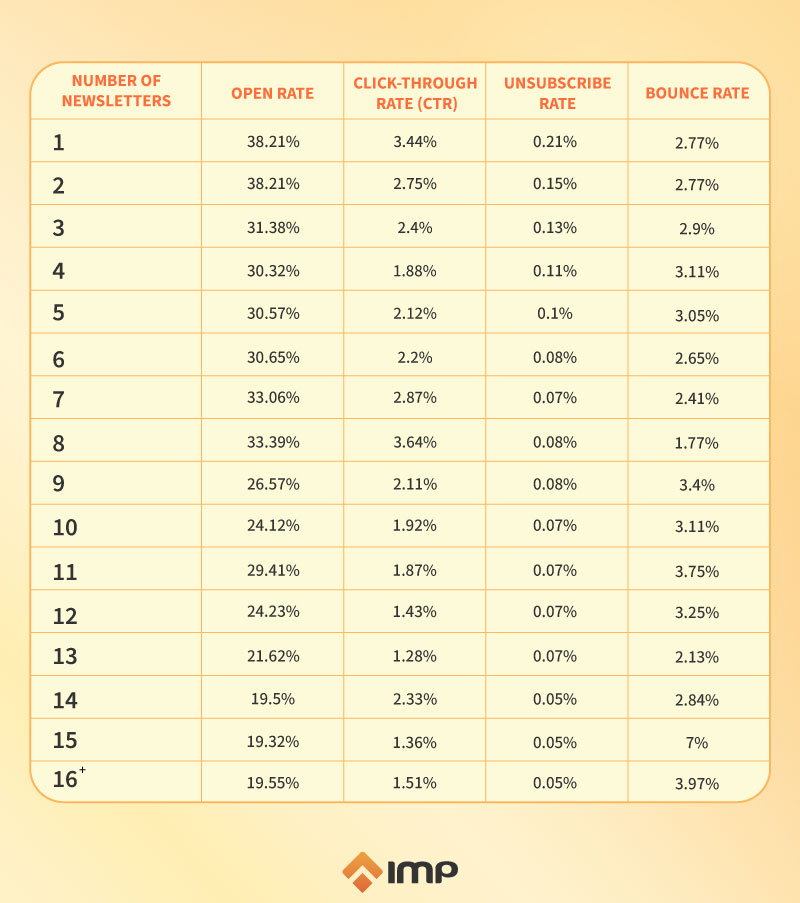
The average open rate for all newsletters sent in 2022 (27.9%) is almost 1.5x higher than that from the previous year (19.3%).
However, a challenge email marketers face is determining the right frequency of emails to avoid triggering unsubscribes. The question then arises: how many emails are too many?
Most marketers choose the safest approach by limiting themselves to sending up to one weekly newsletter. This approach delivers respectable open rates, click-through rates (CTR), and click-to-open rates. Yet, it’s worth noting that it also corresponds to the highest unsubscribe rate.
So, what’s the best strategy here? It’s all about segmentation and content. If you have a small mailing list, respect your subscribers’ time with a weekly newsletter packed with valuable content. But if you have a large audience craving daily discounts and exclusive offers, it’s time to consider a more frequent email schedule.
Landing page conversion by industry
Discover valuable insights into landing page conversions with this comprehensive breakdown of industry-specific subscription rates. Understanding these conversion rates allows you to optimize your landing pages and set realistic goals for your subscription-based initiatives.
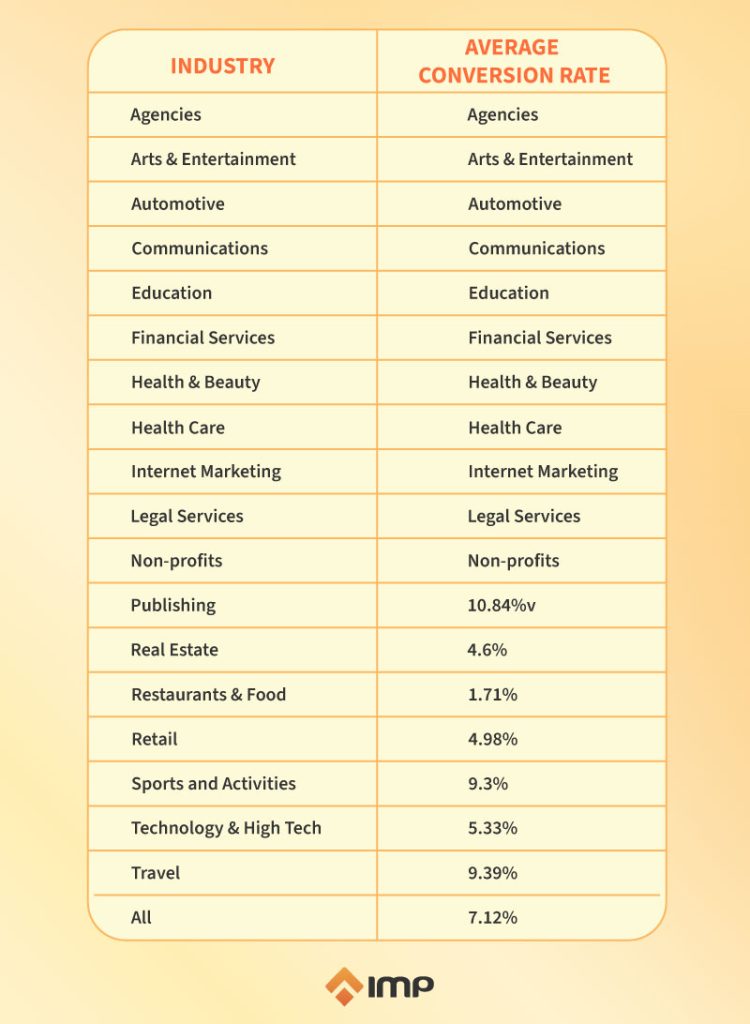
The typical landing page conversion rate was 7.12%, considerably lower than the 17.15% in the 2021 report. The Arts and Entertainment industry scored the highest conversion rate at 18.21%, which was significantly above average. You can observe the lowest conversion rate in the Restaurants and Food industry, at only 1.71%.
How to improve email success metrics today
Use of video
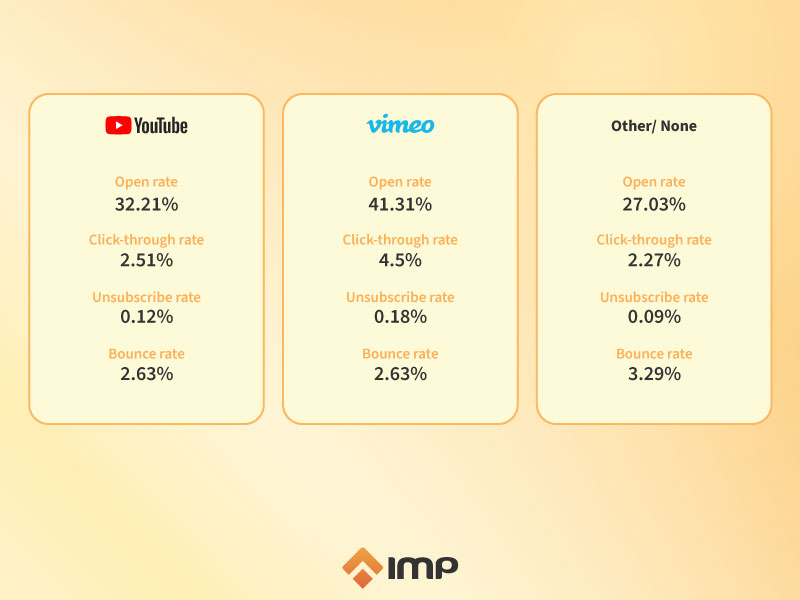
Video content remains a compelling and highly engaging format that deserves a place in your email marketing strategy. Incorporating video into your email communications sets the stage for achieving significantly higher click-through rates and improved email deliverability.
Videos can captivate and tell stories, making them a powerful medium for conveying messages, showcasing products, and delivering educational content. Being aware of technical challenges, including email client compatibility and large file sizes, is essential. To address these challenges, consider using video thumbnails that link to full videos hosted on web pages or platforms and optimize file sizes.
Mobile optimization and accessibility are critical factors to ensure a seamless user experience. By following best practices and analyzing performance metrics, you can harness the power of video to engage and convert your audience effectively.Number of characters in email subject lines
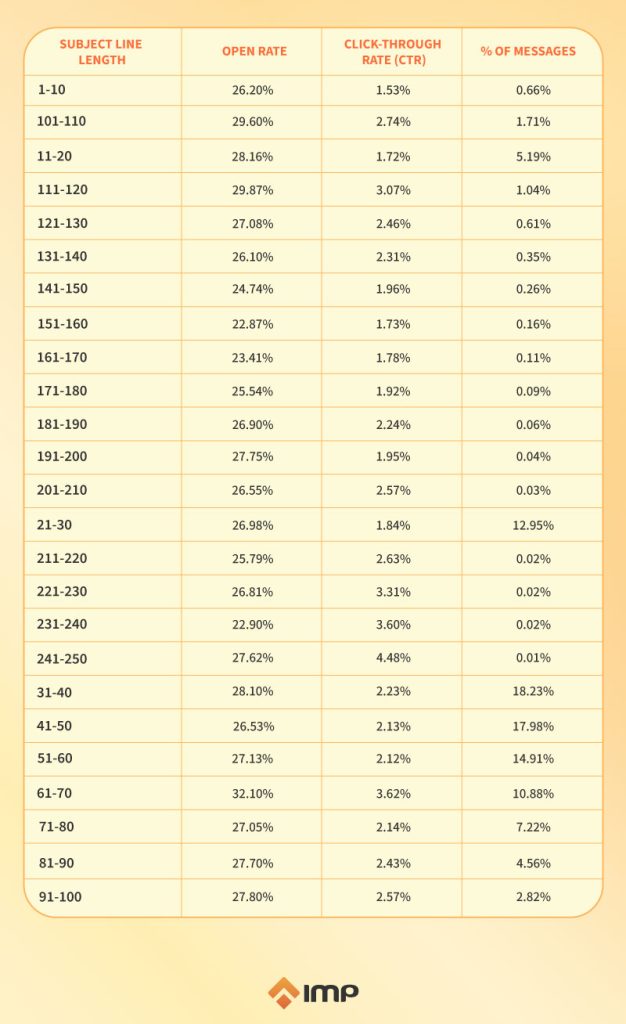
Most emails will trim your subject line to fit on every device screen. So, the best practice has always been to keep your subject lines short. Our data shows that the ideal length of subject lines is the 61-70 characters range.
Emojis in the email subject lines
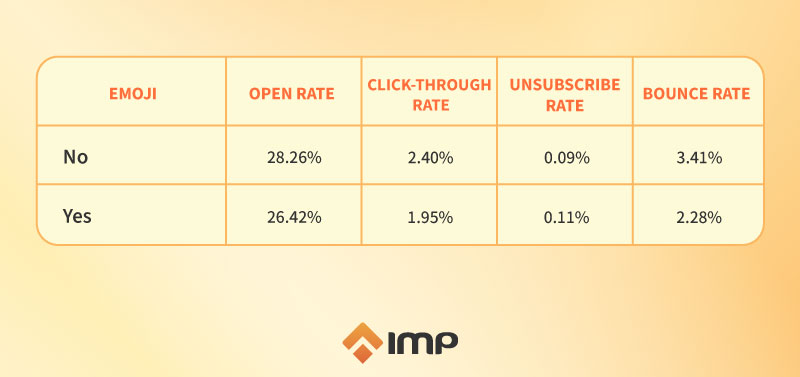
This year’s report indicates that using emojis in email subject lines is a less effective marketing strategy. Key email marketing metrics perform better for communications that do not incorporate emojis.
However, it’s essential to note that the difference in performance is relatively minor, amounting to just 1.84%. This variance may be partly attributed to the fact that most marketers (77%) refrain from using emojis in their subject lines, leading to more data related to their performance.
In light of these findings, it’s crucial to emphasize the importance of tailoring your email strategy to your unique audience. If you need more clarification about the emoji approach, consider conducting A/B tests with and without emojis to gauge their impact on your specific audience. Ultimately, the decision should align with your brand’s tone and resonate effectively with your subscribers.
Personalization in email subject lines
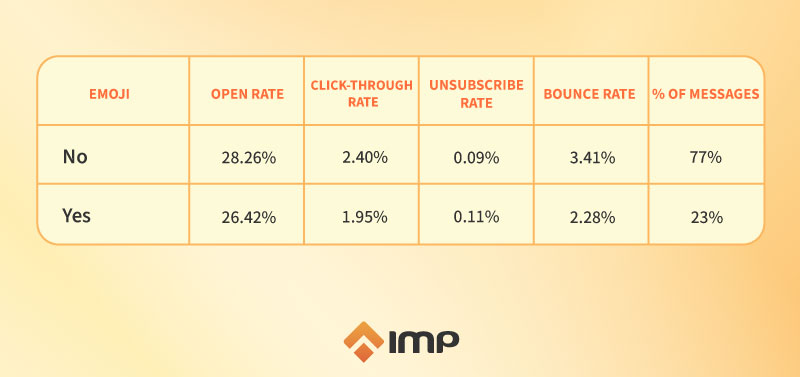
New research shows that personalization may no longer be the key to email success. A whopping 88.52% of marketers have stopped chasing after personalized subject lines. Surprisingly, those who skip personalization experience a 2x higher click-through rate (CTR) than those who go the extra mile (2.49% vs. 1.29%).
But before you ditch personalization altogether, there are still ways to make it work. Instead of simply recognizing first names, make your subject lines valuable and irresistible to recipients. Focus on using personalization for essential factors like contact segmentation, offer customization, individual discounts, birthday surprises, and more.

Phrases in email subject lines
The top five words that led to high open rates were month names, “update,” “events,” “now,” and “news.”
On the other hand, the bottom five words that resulted in meager open rates were “guaranteed,” “compare,” “tested,” “affordable,” and “unlimited.”
However, it’s about more than just using the right words. The way people perceive you and your communications plays a crucial role.
Preheader
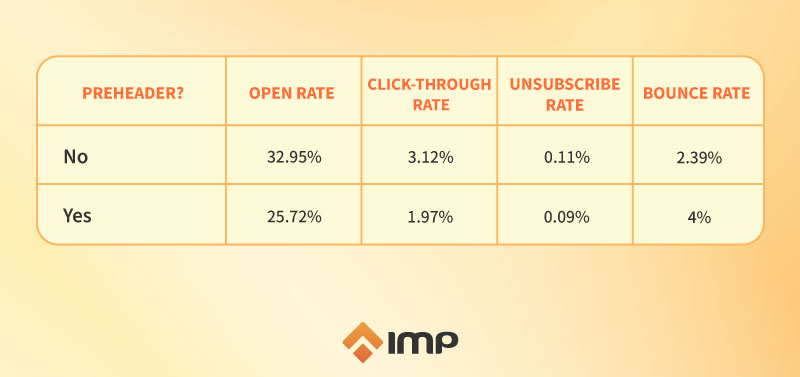
Our analysis found that 34% of all emails contain a preheader. That’s an 8% increase compared to our previous report.
So, how should you design your preheader? Let’s take a look at an example from Interaction-Design.org:
- Subject line: Do not seek praise; seek criticism
- Preheader: Learn how to conduct effective usability testing
As you can see, the subject line and preheader work together to tell a compelling story. You should use all the elements subscribers see in the inbox before they open an email, which is the so-called envelope (sender’s name, subject line, and preheader) that can make a difference. And your average open rates will reflect that.
Welcome emails
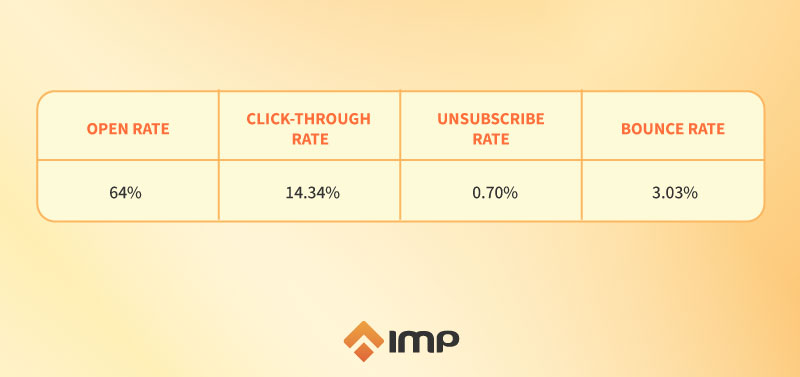
Welcome emails have a high open rate of 63.91% and a strong click-through rate of 14.34%. Even though these rates have slightly decreased, they are three times higher than regular newsletters.
Use welcome emails to tell your brand’s story, share essential links, and highlight your brand’s unique qualities. Plus, an added discount code will convert subscribers into customers.
Image-based vs. text-based emails
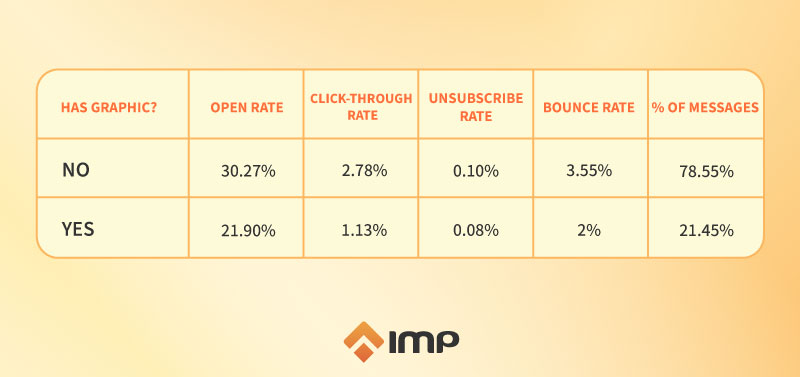
Should your email marketing campaigns be text- or image-based?
The data suggests that image-based emails perform better regarding average open and click-through rates.
The difference is quite significant – 2.78% vs. 1.13% in the case of CTR and 30.27% vs. 21.9% for open rates.
Plus, the CTRs could increase because more eyes are looking at these specific emails. Try both approaches, and A/B test individual messages to find your winning strategy.
Landing page element
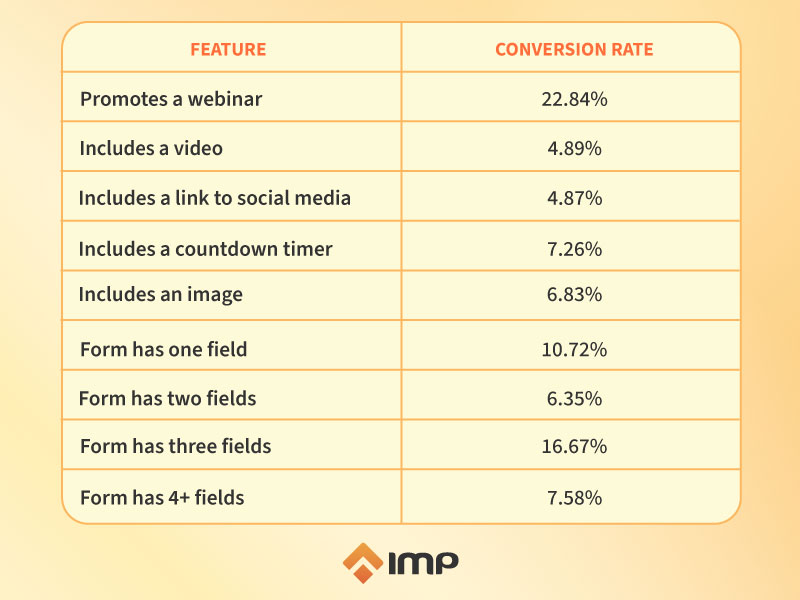
Consumers are craving genuine connections with brands more than ever. That’s why value-based marketing is the key to success. But even more exciting is the incredible 22.84% average conversion rate achieved by well-crafted landing pages promoting live webinars.
People often believe that sign-up forms should be as short as possible. But our research tells a different story. Surprisingly, forms with three fields convert twice as many visitors as those with only two.
Including countdown timers on your landing pages creates a sense of urgency, boosting your conversion rates. However, the same is different for social media links or videos, as they can divert visitors from your main offer. When crafting landing pages, prioritize a visually appealing, concise design that conveys your value proposition.
Conclusion
These benchmarks are vital for evaluating campaign performance, gaining a competitive edge, optimizing resource allocation, and making data-driven decisions.
By targeting specific areas for improvement based on benchmark insights, companies can engage customers more effectively, adapt to technological shifts, optimize ROI, adopt a customer-centric approach, and ensure ongoing adaptation and improvement in the dynamic email marketing landscape.
*References: GetResponse, MailerLite


